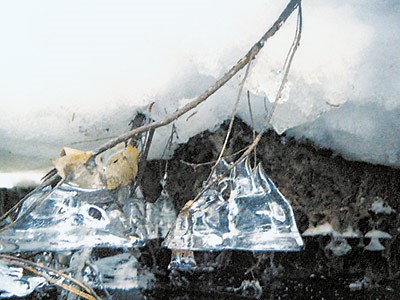On March 20, spring arrived at long last. But this is still March, so it is only the first part of spring that we see through the window this morning.
The first month of spring is a lot like winter, snow and ice. The second part of spring is mud and the third part of spring is blackflies.
Clearly, this first part of spring is the best. For a couple of weeks at least, I will be taking daily walks through the forest, across vast wetlands and often on the lake. We have a wonderful lake — no currents, just lots of ice that stays solid until most days and nights stay above freezing.
The rotten rainy weather we had on March 11 and 12 was followed with several cold, crisp days and nights. The rain turned all the snow on the lake to slush, then the cold days froze it all solid as the rocks along the shore. A few centimetres of snow made for perfect travel conditions.
In the forest, the top layers of snow got thoroughly soaked before the cold came. Now, there is a thick hard crust. I can walk anywhere — no snowshoes required, at least in the mornings. Sometimes, the sunny spots under the trees will soften and I’ll crunch through the 30 centimetres of snow that remains in the bush.
Because it is the first month of spring, the forest takes on sights and sounds that are muffled by the deep and cold snow of real winter. The streams start to flow. Little streams and big rivers. Flowing water makes its way. My favourite places to walk in early spring sing with the sound of rushing water.
A series of cold nights will attempt to tuck the water out of sight again, but it is too late. Like an egg opened on Easter morning, it can’t be put back into the wrapping again. The products of these cold nights are displayed in a brilliant sparkle of ice formations. The ice tries to cover the water, but the water always keeps a path open.
The little stream I walk along today is only a half-meter wide at most and only a few centimetres deep. Its bank rises 40 cm from the stream bed and the snow rises another 25 cm above that.
I lie on my belly in the snow and reach down to take photos. I capture the beauty and variety of the ice formations to take home, perhaps to submit to the Picture Our Lakes Calendar. Or, maybe to make my own calendar.
There’s room for only one in this printed form of Northern Life. You can see a few more at NorthernLife.ca.
Viki Mather has been commenting for Northern Life on the natural world and life in Greater Sudbury since the spring of 1984.
Join Sudbury.com+
- Messages
- Post a Listing
- Your Listings
- Your Profile
- Your Subscriptions
- Your Likes
- Your Business
- Support Local News
- Payment History
Sudbury.com+ members
Already a +member?
Not a +member?
Sign up for a Sudbury.com+ account for instant access to upcoming contests, local offers, auctions and so much more.
